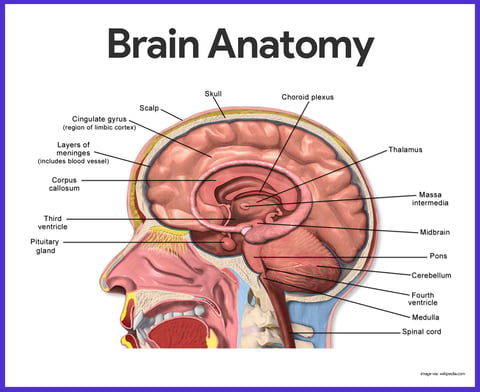10 Lectures from the OSU Explorations in Neuroscience Program
My takeaways from all the lectures given during the 5-day OSU Neuroscience summer camp I described in my previous blog, "Discovering the World of Neuroscience..."
SCIENCE


Lecture 1: Overview of the Nervous System
A general overview of the brain was given here. Questions about how the brain functions, what each part of the brain is responsible for, how it relates to our lives, and how much of our body it composes were all answered. Dr. Bishop explained to us that, relative to our body, our brain is pretty big; size is partly related to body size but not entirely. If you were to flatten out a brain, it would be the size of a newspaper; it's just crumpled into a skull.
Check out these brain facts I noted down:
The brain is 3 lbs (2-3% of a person's body weight).
20% of our body's total energy consumption is from the brain.
75% of the brain is water, 25% cholesterol, and 60% is fat.
The brain triples in size in the first year of life.
There are a hundred billion neurons and a hundred trillion synaptic
connections in the brain.
The brain doesn't feel pain, since there aren't any nerves in it.
The brain is responsible for all motor activity—somatic and autonomic.
Lecture 2 - Your Brain on Drugs
What happens to our brain when it's exposed to drugs like nicotine? Nicotine, the highly addictive substance found in tobacco products, impacts many Americans every day. But who is most affected by smoking, and in what ways?
We know that nicotine is extremely addictive, which is why so many people use tobacco. However, does this mean that vapes, which also contain nicotine, are a safer alternative? Not necessarily. Both smoking and vaping have overwhelmingly negative long-term effects on health. In fact, smoking is responsible for the deaths of a staggering 33% of Americans each year.
Smoking and vaping don't just harm the individual; they also have far-reaching effects on families, communities, and the healthcare system. While some might think that vaping is a better option, it's important to remember that it still exposes users to nicotine and other harmful substances. So, the best choice for health is to avoid both smoking and vaping altogether.
Lecture 3 - Exploring the Environment
The ability to navigate is essential to complex life. By exploring how different creatures move through their environments, we can gain insights into how their brains function. For example, bacteria need to move towards food sources, and they do this using their flagella, which are tail-like structures that propel them through their surroundings. Ants, on the other hand, need to find their way back to their nests, so they search for familiar patches of ground and use pheromone trails to mark their paths.
The professor then discussed the various pathways humans use to navigate. For instance, we rely on and remember landmarks to help us find our way. This use of landmarks is a fundamental navigation strategy that reflects how our brains process and store spatial information.
Different models of navigation remind us that the way we perceive and move through the world is shaped by our cognitive processes. Comparative studies of navigation in different species provide valuable insights into these processes. They reveal not just positive associations, such as the connection between brain structure and navigation ability, but also a deeper understanding of the underlying mechanisms.
By examining these diverse navigation strategies, we can better understand how both simple and complex brains are wired to interpret and respond to their environments. This knowledge not only sheds light on the fascinating behaviors of different species but also enhances our understanding of human cognition and the evolutionary basis of navigation.
Lecture 4 - The Neurosurgery That Connected the World
This lecture was by far my favorite; it was both informative and incredibly engaging! Here is what she taught:
Initially, there was a significant debate about the roles of the brain versus the heart in human anatomy and function. Without modern access to internal organs, early scientists and anatomists often relied on dissecting the bodies of gladiators to understand human anatomy. This led to various interpretations and attempts to contextualize their findings.
Before Leonardo da Vinci's detailed neuroanatomy drawings, there were already rudimentary ideas about brain function. One of the earliest and most intriguing surgical procedures was trepanation, the intentional boring of holes in the skull. Evidence from the Stone Age shows that people survived this procedure, although the reasons behind it remain unclear. It might have been performed to treat illnesses, relieve pain, or address mental health issues.
Trepanation is one of the earliest known surgical procedures, first documented in 1685 and continuing into the 19th century. Despite geographical barriers, people used tools like rock drills and knives for this procedure, suggesting it might have been performed to treat conditions like epilepsy or mental illnesses, often referred to as "the stone of madness."
This practice highlights a shared human experience and independent problem-solving across different cultures. It underscores that great thinkers and significant discoveries belong to no single culture or group, emphasizing the universal nature of human curiosity and medical advancement.
Lecture 5 - What a career in neuroscience looks like
The fifth lecture focused on careers in neuroscience and what they entail. To become an adult neurologist, one needs four years of college, four years of medical school, and four years of residency. For pediatric neurology, the pathway is similar, but it requires five years of residency. Neurology encompasses various careers, all of which involve evaluating symptoms to ensure the nervous system is functioning properly.
Diagnostic tests are a crucial part of neurology. For example, motor and cerebellar tests are conducted to assess neurological function. Different neurological methods were discussed, such as:
EEG (Electroencephalogram): Measures electrical activity in the brain and waveforms.
EMG (Electromyography): A type of nerve conduction study.
CT Scan (Computed Tomography): Uses X-rays to create cross-sectional images of the body.
tPA (Tissue Plasminogen Activator): A medication used to dissolve blood clots, often administered to treat patients with strokes or aphasia. If not given promptly, brain damage can be permanent.
MRI (Magnetic Resonance Imaging): Uses magnets and radio waves to generate detailed images, often more precise than a CT scan.
fMRI (Functional MRI): Measures changes in blood flow in the brain during activity, showing which parts of the brain are active during specific tasks.
Lumbar Puncture (Spinal Tap): Involves withdrawing cerebrospinal fluid (CSF) to check for infections or inflammation.
The lecture also covered Botox injections, not for aesthetic purposes but for treating headaches and muscle disorders. This comprehensive overview highlighted the diverse and complex nature of careers in neurology, emphasizing the importance of various diagnostic tools and treatments in ensuring the health of the nervous system.
Lecture 6 - Music and Memory
The sixth session wasn't a traditional lecture; it was more of an interactive activity focused on dementia. We learned that dementia is far more prevalent than most people realize, affecting many individuals and making it difficult for them to remember certain events. A group at OSU, known as Musical Memories: The Minter Project, volunteers at memory care facilities to host silent disco events for people with dementia.
Music has a powerful connection to memory, and these silent discos offer a unique and enjoyable experience for participants. The music helps trigger memories, allowing individuals to recall moments from their past, sometimes from their teenage years or other significant times in their lives. These events not only provide a fun time for those with dementia but also serve as a therapeutic tool to help them remember things more clearly.
During the session, we got the chance to experience the silent disco ourselves, using the equipment to understand how it works. It was enlightening to see firsthand how music can have such a profound impact on memory and how initiatives like the Minter Project can make a meaningful difference in the lives of those with dementia.
Lecture 7 - Deep Brain Stimulation as a treatment for Parkinson's Disease
Diseases like epilepsy and Parkinson's disease are often characterized by movement difficulties and resting tremors. These symptoms are generally linked to the basal ganglia, the part of the brain that controls movement. One potential treatment for Parkinson's disease is L-Dopa, but it comes with challenges such as systemic effects, difficulty in adjusting the dosage, and the risk of hallucinations.
Another promising treatment is deep brain stimulation (DBS). This procedure involves implanting a pacemaker-like device in the brain, with wires connected to specific nuclei that regulate movement and neuron activity. DBS can help manage the symptoms of Parkinson's disease, offering hope for improved movement control and overall quality of life for those affected by the condition.
Deep brain stimulation is a cutting-edge approach that not only addresses movement disorders but also highlights the advancements in medical technology. It provides a potential alternative for patients who may not respond well to medication like L-Dopa. By directly targeting the brain's movement control centers, DBS represents a significant step forward in the treatment of neurological disorders.
Lecture 8 - Patient Panel
This interactive event allowed students to ask questions and receive firsthand insights about life with multiple sclerosis (MS), treatment options, and pursuing a career in neurology. This patient panel featured two individuals living with MS, the spouse of one of the patients, and their doctor. The patients shared their personal experiences, discussing the challenges they face daily, the impact of the disease on their physical and emotional well-being, and the strategies they use to manage symptoms. The spouse provided a unique perspective on supporting a loved one with MS, highlighting the importance of a strong support system and effective communication.
The doctor offered a medical viewpoint, explaining the latest advancements in MS treatments and the importance of early diagnosis and intervention. Students were particularly interested in understanding the doctor’s journey into the field of neurology and gaining valuable advice on how to prepare for a career dedicated to treating neurological disorders. The panel provided a comprehensive view of multiple sclerosis, emphasizing the collaborative effort between patients, families, and healthcare providers in managing the disease and improving quality of life.
Lecture 9 - Neurotrama: a focus on spinal cord injury
This lecture on neurotrauma provided an in-depth exploration of traumatic injuries to the nervous system, focusing on the brain and spinal cord. The speaker, a leading expert in the field, began by explaining the various causes of neurotrauma, including accidents, falls, sports injuries, and violence. The lecture covered the immediate and long-term effects of these injuries, highlighting symptoms such as cognitive impairments, motor deficits, and emotional challenges.
A significant portion of the lecture was dedicated to the latest advancements in diagnosing and treating neurotrauma. The speaker discussed the use of advanced imaging techniques to assess the extent of injuries and the role of cutting-edge surgical and non-surgical interventions in patient recovery. Emphasis was placed on the importance of timely medical response and the critical role of rehabilitation in restoring function and improving quality of life.
Students were engaged throughout the lecture, asking insightful questions about the complexities of neurotrauma and the multidisciplinary approach required for effective treatment. The speaker also shared real-life case studies, providing a practical perspective on the challenges and successes in managing neurotrauma. This lecture not only deepened the students' understanding of the subject but also inspired many to consider specializing in neurotrauma care, underscoring the significant impact of continued research and innovation in this vital area of medicine.
Lecture 10 - Overview of Neuroscience Major @ OSU


